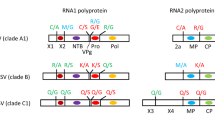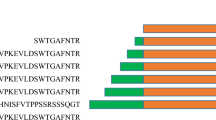Abstract
Nuclear inclusion a protease (NIaPro), a major protease of potyvirids, processes its cognate viral polyprotein at distinct cleavage sites. Although Potyviridae is the largest family of the realm Riboviria, the individual NIaPro enzymes and their cleavage sites are believed to be species-specific. In the present study, the NIaPro amino acid sequences of 165 potyvirids of 10 genera and their 1154 cleavage sites were compared to understand their genus/species-specificity and functional regulation. Of these, the NIaPro of macluraviruses, maintains a constant length of 217 amino acids, while those of other genera allow variation. In particular, poaceviruses exhibited a broad range of NIaPro amino acid sequence lengths. Alignment of 162 NIaPro amino acid sequences showed that the N- and C-terminal regions allow variations, while the central region, with the catalytic triad and S1 subsite, are highly conserved. NIaPro cleavage sites are composed of seven amino acids (heptapeptide) denoted as P6-P5-P4-P3-P2-P1/P1’. A survey of 1154 cleavage sites showed that the P1 position is predominantly occupied by Gln/Glu, as is seen in picornaviruses. The P6 (Glu), P4 (Val/Cys/Gln), P2 (His/Tyr/Leu), and P1’ (Ser/Ala/Gly/Met) positions are predominantly occupied by genus-specific residues, while P5 and P3 are not genus-specific. The 6K2-VPg and VPg-NIaPro junctions possess Glu at the P1 position in order to maintain latency.




Similar content being viewed by others
References
Sankaranarayanan R, Palani SN, Kumar A, AS PS, Tennyson J (2020) Prediction and experimental confirmation of banana bract mosaic virus encoding miRNAs and their targets. ExRNA 2(1):5
Ivanov KI, Eskelin K, Lohmus A, Makinen K (2014) Molecular and cellular mechanisms underlying potyvirus infection. J Gen Virol 95(7):1415–1429
Riechmann JL, Lain S, Garcia JA (1992) Highlights and prospects of potyvirus molecular biology. J Gen Virol 73(1):1–16
Revers F, Garcia JA (2015) Molecular biology of potyviruses. In: Maramorosch K, Mettenleiter TC (eds) Advances in virus research, 1st edn. Academic Press, New York, pp 101–199
Martinez F, Rodrigo G, Aragones V, Ruiz M, Lodewijk I, Fernandez U, Elena SF, Daros JA (2016) Interaction network of tobacco etch potyvirus NIa protein with the host proteome during infection. BMC Genom 17(1):87
Kapust RB, Tozser J, Copeland TD, Waugh DS (2002) The P1′ specificity of tobacco etch virus protease. Biochem Biophys Res Commun 294(5):949–955
Wehr MC, Laage R, Bolz U, Fischer TM, Grunewald S, Scheek S, Bach A, Nave KA, Rossner MJ (2006) Monitoring regulated protein-protein interactions using split TEV. Nat Methods 3(12):985–993
Han HE, Sellamuthu S, Shin BH, Lee YJ, Song S, Seo JS, Baek IS, Bae J, Kim H, Yoo YJ, Jung YK (2010) The nuclear inclusion a (NIa) protease of turnip mosaic virus (TuMV) cleaves amyloid-β. PLoS One 5(12):e15645
Adams MJ, Antoniw JF, Beaudoin F (2005) Overview and analysis of the polyprotein cleavage sites in the family Potyviridae. Mol Plant Pathol 6(4):471–487
Palani SN, Sankaranarayanan R, Tennyson J (2018) Wuhan poty-like virus 1 is a possible member of the genus Macluravirus. Arch Virol 163(11):3167–3169
Spitzer M, Wildenhain J, Rappsilber J, Tyers M (2014) BoxPlotR: a web tool for generation of box plots. Nat Methods 11(2):121
Vigneshwari GM, Ramamoorthy S, Muralikrishnan A, Srivastava P, Pathania M, Krishnaswamy S (2016) MPDB. Bioinformation 12(2):32
Huang CH, Tai CH, Lin RS, Chang CJ, Jan FJ (2019) Biological, pathological, and molecular characteristics of a new potyvirus, dendrobium chlorotic mosaic virus. Infecting Dendrobium Orchid. Plant Dis 103(7):1605–1612
Perotto MC, Pozzi EA, Celli MG, Luciani CE, Mitidieri MS, Conci VC (2018) Identification and characterization of a new potyvirus infecting cucurbits. Arch Virol 163(3):719–724
Wang R, Chen B, Li Y, Wang T, Ding W (2020) Complete genomic sequence of crow-dipper mosaic-associated virus, a novel macluravirus infecting Pinellia ternata. Arch Virol 165(2):491–494
Stedman KM (2015) Deep recombination: RNA and ssDNA virus genes in DNA virus and host genomes. Annu Rev Virol 2:203–217
Phan J, Zdanov A, Evdokimov AG, Tropea JE, Peters HK, Kapust RB, Li M, Wlodawer A, Waugh DS (2002) Structural basis for the substrate specificity of tobacco etch virus protease. J Biol Chem 277(52):50564–50572
Sun P, Austin BP, Tozser J, Waugh DS (2010) Structural determinants of tobacco vein mottling virus protease substrate specificity. Protein Sci 19(11):2240–2251
Parks TD, Dougherty WG (1991) Substrate recognition by the NIa proteinase of two potyviruses involves multiple domains: Characterization using genetically engineered hybrid proteinase molecules. Virology 182(1):17–27
Ziebuhr J, Bayer S, Cowley JA, Gorbalenya AE (2003) The 3C-like proteinase of an invertebrate nidovirus links coronavirus and potyvirus homologs. J Virol 77(2):1415–1426
Mann KS, Walker M, Sanfacon H (2017) Identification of cleavage sites recognized by the 3C-like cysteine protease within the two polyproteins of strawberry mottle virus. Front Microbiol 8:745
Wamaitha MJ, Nigam D, Maina S, Stomeo F, Wangai A, Njuguna JN, HoltonTA Wanjala BW, Wamalwa M, Lucas T, Djikeng A, Garcia-Ruiz H (2018) Metagenomic analysis of viruses associated with maize lethal necrosis in Kenya. Virol J 15(1):90
Nigam D, LaTourrette K, Souza PF, Garcia-Ruiz H (2019) Genome-wide variation in potyviruses. Front Plant Sci 10:1439
Sankaranarayanan R, Palani SN, Tennyson J (2019) Hubei poty-like virus 1 is likely an interspecies recombinant of sugarcane mosaic virus and putative bean yellow mosaic virus. Arch Virol 164(1):261–265
Simon-Loriere E, Holmes EC (2011) Why do RNA viruses recombine? Nat Rev Microbiol 9(8):617
Carrington JC, Haldeman R, Dolja VV, Restrepo-Hartwig MA (1993) Internal cleavage and trans-proteolytic activities of the VPg-proteinase (NIa) of tobacco etch potyvirus in vivo. J Virol 67(12):6995–7000
Tozser J, Tropea JE, Cherry S, Bagossi P, Copeland TD, Wlodawer A, Waugh DS (2005) Comparison of the substrate specificity of two potyvirus proteases. FEBS J 272(2):514–523
Wei T, Wang A (2008) Biogenesis of cytoplasmic membranous vesicles for plant potyvirus replication occurs at endoplasmic reticulum exit sites in a COPI-and COPII-dependent manner. J Virol 82(24):12252–12264
Rajamaki ML, Valkonen JP (2009) Control of nuclear and nucleolar localization of nuclear inclusion protein a of picorna-like Potato virus A in Nicotiana species. Plant Cell 21(8):2485–2502
Acknowledgements
Author SNP thanks the Science and Engineering Research Board (SERB) for fellowship support.
Funding
This work was funded by the Science and Engineering Research Board (SERB), Government of India, under project no. CRG/2018/002106.
Author information
Authors and Affiliations
Contributions
SNP and TJ designed this study. Sequence retrieval and analysis were performed by SNP and RS. SNP wrote the manuscript, and RS and TJ edited the manuscript.
Corresponding author
Ethics declarations
Conflict of interest
The authors declare that they have no conflict of interest.
Ethical approval
This article does not contain any studies with human participants or animals performed by any of the authors.
Additional information
Handling Editor: Massimo Turina.
Publisher's Note
Springer Nature remains neutral with regard to jurisdictional claims in published maps and institutional affiliations.
Supplementary Information
Below is the link to the electronic supplementary material.
Rights and permissions
About this article
Cite this article
Palani, S.N., Sankaranarayanan, R. & Tennyson, J. Comparative study of potyvirid NIa proteases and their cleavage sites. Arch Virol 166, 1141–1149 (2021). https://doi.org/10.1007/s00705-021-04997-0
Received:
Accepted:
Published:
Issue Date:
DOI: https://doi.org/10.1007/s00705-021-04997-0




